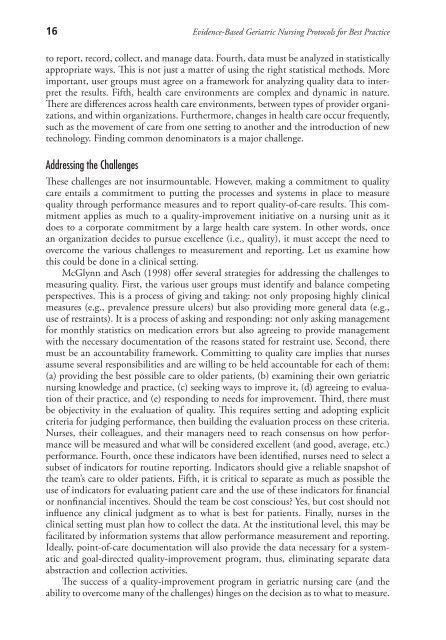Evidence-Based Geriatric Nursing - Springer Publishing
Evidence-Based Geriatric Nursing - Springer Publishing
Evidence-Based Geriatric Nursing - Springer Publishing
Create successful ePaper yourself
Turn your PDF publications into a flip-book with our unique Google optimized e-Paper software.
16<br />
<strong>Evidence</strong>-<strong>Based</strong> <strong>Geriatric</strong> <strong>Nursing</strong> Protocols for Best Practice<br />
to report, record, collect, and manage data. Fourth, data must be analyzed in statistically<br />
appropriate ways. This is not just a matter of using the right statistical methods. More<br />
important, user groups must agree on a framework for analyzing quality data to interpret<br />
the results. Fifth, health care environments are complex and dynamic in nature.<br />
There are differences across health care environments, between types of provider organizations,<br />
and within organizations. Furthermore, changes in health care occur frequently,<br />
such as the movement of care from one setting to another and the introduction of new<br />
technology. Finding common denominators is a major challenge.<br />
Addressing the Challenges<br />
These challenges are not insurmountable. However, making a commitment to quality<br />
care entails a commitment to putting the processes and systems in place to measure<br />
quality through performance measures and to report quality-of-care results. This commitment<br />
applies as much to a quality-improvement initiative on a nursing unit as it<br />
does to a corporate commitment by a large health care system. In other words, once<br />
an organization decides to pursue excellence (i.e., quality), it must accept the need to<br />
overcome the various challenges to measurement and reporting. Let us examine how<br />
this could be done in a clinical setting.<br />
McGlynn and Asch (1998) offer several strategies for addressing the challenges to<br />
measuring quality. First, the various user groups must identify and balance competing<br />
perspectives. This is a process of giving and taking: not only proposing highly clinical<br />
measures (e.g., prevalence pressure ulcers) but also providing more general data (e.g.,<br />
use of restraints). It is a process of asking and responding: not only asking management<br />
for monthly statistics on medication errors but also agreeing to provide management<br />
with the necessary documentation of the reasons stated for restraint use. Second, there<br />
must be an accountability framework. Committing to quality care implies that nurses<br />
assume several responsibilities and are willing to be held accountable for each of them:<br />
(a) providing the best possible care to older patients, (b) examining their own geriatric<br />
nursing knowledge and practice, (c) seeking ways to improve it, (d) agreeing to evaluation<br />
of their practice, and (e) responding to needs for improvement. Third, there must<br />
be objectivity in the evaluation of quality. This requires setting and adopting explicit<br />
criteria for judging performance, then building the evaluation process on these criteria.<br />
Nurses, their colleagues, and their managers need to reach consensus on how performance<br />
will be measured and what will be considered excellent (and good, average, etc.)<br />
performance. Fourth, once these indicators have been identified, nurses need to select a<br />
subset of indicators for routine reporting. Indicators should give a reliable snapshot of<br />
the team’s care to older patients. Fifth, it is critical to separate as much as possible the<br />
use of indicators for evaluating patient care and the use of these indicators for financial<br />
or nonfinancial incentives. Should the team be cost conscious? Yes, but cost should not<br />
influence any clinical judgment as to what is best for patients. Finally, nurses in the<br />
clinical setting must plan how to collect the data. At the institutional level, this may be<br />
facilitated by information systems that allow performance measurement and reporting.<br />
Ideally, point-of-care documentation will also provide the data necessary for a systematic<br />
and goal-directed quality-improvement program, thus, eliminating separate data<br />
abstraction and collection activities.<br />
The success of a quality-improvement program in geriatric nursing care (and the<br />
ability to overcome many of the challenges) hinges on the decision as to what to measure.

















